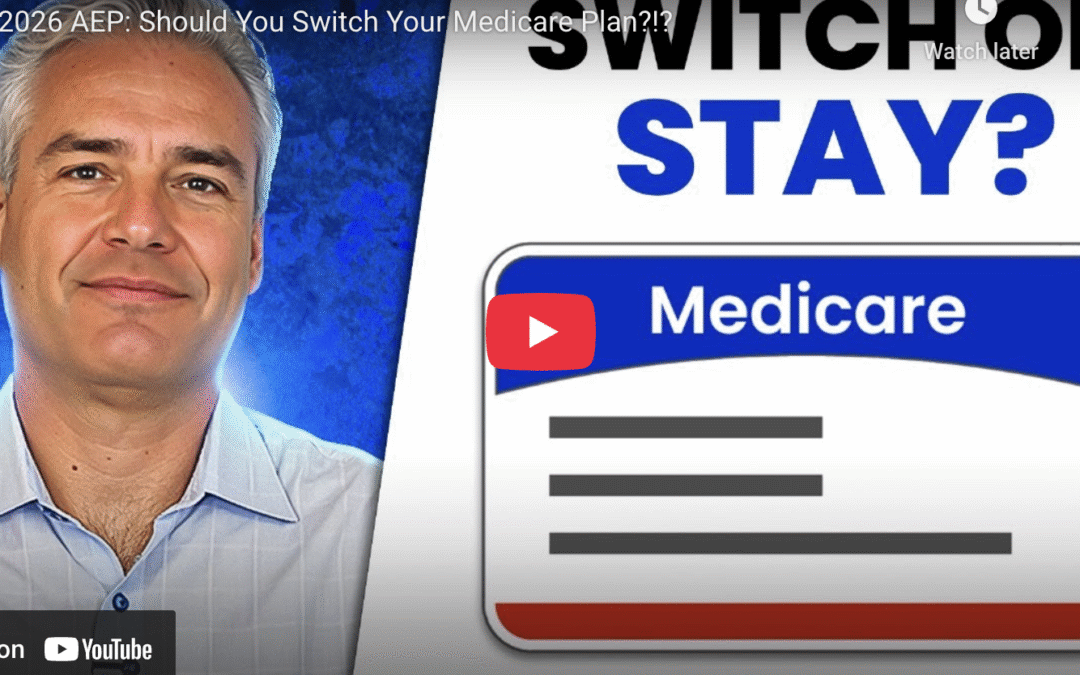If you’re wondering, “Will my plan change next year? Will my doctors stay in-network? Am I going to pay more?” — you’re not alone. AEP is noisy on purpose. Mailers, commercials, and phone calls all say “switch now.”
Truth: most people don’t need to switch.
Also true: some definitely should — and for the right reasons. Below I’ll show you how to tell which camp you’re in so you can make the call before December 7.
Watch: 2026 AEP — Should You Switch Your Medicare Plan?!?
Key Takeaways
-
Don’t switch just because an ad told you to. Switch because your doctors, drugs, costs, or risk changed.
-
Six “switch triggers” to watch: provider or pharmacy drops your plan, drug tier jumps or deductible adds/raises, billing/payment issues, shrinking extras, higher MOOP, or no review in 2+ years.
-
Bad reasons to move: glossy mailers, neighbor’s plan, vague promises, or an agent who can’t show why it’s better for your doctors and drugs.
-
If you do switch, know the common paths (MA→MA, MA→Medigap+Part D with possible GI after a termination/SAR, Medigap→MA) and the gotchas in each.
-
Use a simple 5-point checklist (docs, drugs, total-cost math, risk tolerance, letters/timing) to decide before Dec 7, so coverage starts smoothly Jan 1, 2026.
6 Good Reasons to Question Your Current Coverage (The “Switch Triggers”)
1) Your doctor or pharmacy dropped your plan.
This is the #1 driver of change. Action: call the billing office and ask for the exact plan name they’ll accept in 2026 (not just the brand). If they say “not taking that plan,” review options.
2) Your prescriptions got pricier or moved tiers.
I’m seeing more tier inflation, new/raised drug deductibles, and co-insurance replacing flat co-pays. Action: check the 2026 formulary and pricing, or have an independent agent run a drug comparison.
3) Billing weirdness and delayed payments.
Duplicate bills or “balance due” notes can signal back-end changes at the insurer. It’s not panic time, but treat it as an early warning and review before AEP ends.
4) Extras shrank (dental/vision/hearing/OTC).
If your dental dropped or your OTC cadence changed, your real yearly cost just went up even if the premium didn’t. Action: add extras into your annual math.
5) Your MOOP (maximum out-of-pocket) rose.
A higher MOOP = more risk on you. If you manage chronic conditions, that can mean thousands more at stake.
6) You haven’t reviewed in 2+ years.
Plans change annually; star ratings and service levels move, too. A quick comparison now can save a headache later.
Rule of thumb: If two or more triggers hit — or you received a service area reduction/termination — compare plans now.
Why You Shouldn't Switch
There are plenty of bad reasons people move (and regret it):
-
Glossy mailers or loud ads promising shiny new perks.
-
Neighbor recommendations (their county/doctors/drugs ≠ yours).
-
A vague sales pitch without clear, written proof it’s better for your doctors, drugs, and costs.
If your doctors are in-network, drugs are affordable, MOOP is reasonable, and the plan still fits how you actually use care, staying put is a confident choice.
If You Do Switch: What It Actually Looks Like
MA → MA (most common). Straightforward, but still verify doctors/hospitals and drug costs plan-by-plan.
MA → Medigap + Part D. Often after a termination/service area reduction. Tip: a SAR letter can open a ~63-day Guaranteed Issue window for certain Medigap plans (state rules vary).
Medigap → MA. Often for premiums or added extras. Must-do: confirm your specialists and hospitals are in-network before you apply.
The 5-Point AEP Decision Checklist (Use This Today)
-
Docs & Hospitals: Call and confirm the exact 2026 plan name they accept.
-
Pharmacy & Drugs: Run a 2026 drug comparison (independent agent or Medicare’s plan finder).
-
Total-Cost Math: Premium + expected co-pays/coinsurance + MOOP = your real annual exposure.
-
Risk Tolerance: If a surprise $3,000 bill would break your budget, favor predictability over splashy extras.
-
Letters & Timing: A termination/SAR letter usually triggers a GI window for Medigap (commonly 63 days from the letter date). Don’t miss it.
FAQs
My plan is ending — do I have special rights?
Yes. A termination or service area reduction can open a time-limited Guaranteed Issue path into certain Medigap plans (state rules vary). Watch the dates on your letter.
Provider directories show my doctor, but the office says “no.” Who’s right?
Trust the billing office over the directory during AEP. Online listings lag; contracts finalize late.
Are $0 premiums always better?
The $0 premium plans aren’t better if your MOOP, co-pays, or drug costs are higher. Total cost > premium alone.
Can I undo a bad switch?
Generally, you’re locked until the next enrollment window unless you qualify for a Special Enrollment Period.
What To Do Next
Decide with data, not noise.
-
Verify providers, confirm drugs, and do the total-cost math.
-
If two+ triggers apply — or you received a termination/SAR letter — shop now.
-
If everything still fits your life and budget, stay with confidence.
Want help pressure-testing the numbers? Schedule a quick, no-pressure conversation with an independent, licensed Medicare advisor to compare options side-by-side before December 7.




